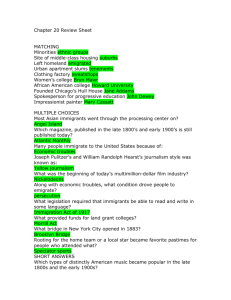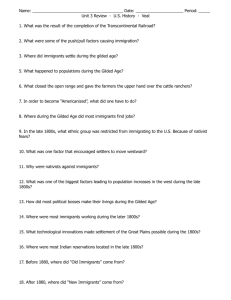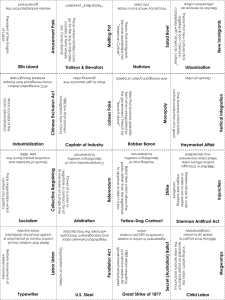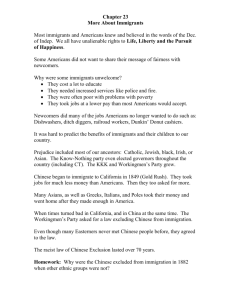The Rise of Urban America
advertisement
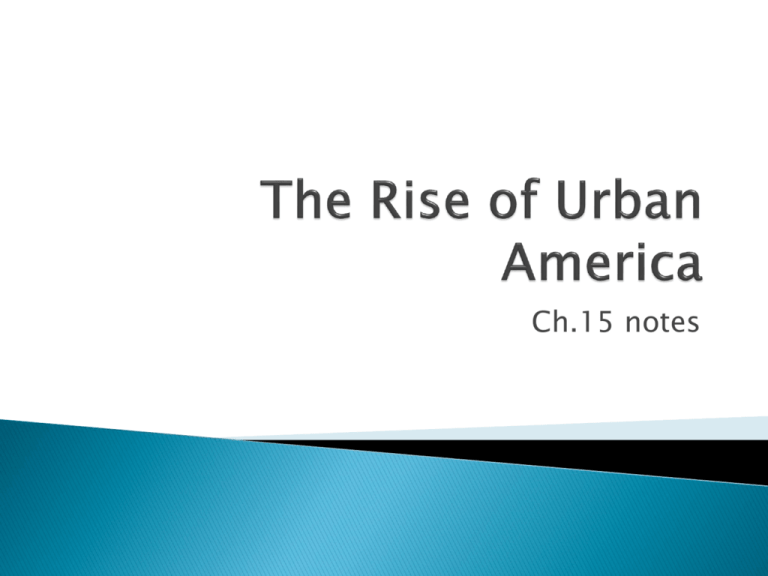
Ch.15 notes By the 1890s over half of all immigrants in the U.S. were eastern and southern Europeans, including Italians, Greeks, Poles, Slavs, Russians, and Armenians. Moving to the U.S. offered immigrants a chance to break away from Europe’s class system and move to a democratic nation where they had a chance to move up the social ladder. The eastern and southern Europeans who came to America in the last half of the 19th century had to endure a difficult voyage across the Atlantic Ocean. Upon arrival they would have to pass an inspection and be processed on Ellis Island in New York Harbor. Many of those who passed the Ellis Island inspections settled in NYC, Chicago, Milwaukee, and Detroit. As Europeans were coming to America via a voyage across the Atlantic, many Asian immigrants began crossing the Pacific to arrive on America’s west coast in the mid1800s. The 1848 discovery of gold in California began to lure Chinese immigrants to the U.S. initially, and then the Taiping Rebellion took around 20 million lives and caused such great suffering that many Chinese fled to the U.S. In Jan. 1910, CA opened a barracks on Angel Island to accommodate the Asian immigrants. Most of these immigrants were young males in their teens or twenties. From Angel Island many Chinese immigrants spread out into western cities where they worked as laborers or servants in skilled trades. Some worked as merchants. Eventually the large amount of immigrants to America led to an increased feeling of Nativism, which is an exteme dislike for immigrants and a desire to limit immigration. Nativism led to the creation of two antiimmigrant organizations. One, the American Protective Association, and the second was the Workingman’s Party of CA. The passing of the Chinese Exclusion Act in 1882 was an obvious result of increased Nativism. The law barred Chinese immigration for ten years and prevented Chinese already in the U.S. from becoming citizens. Chinese immigrants protested the exclusion act arguing the white Americans didn’t oppose immigration by Italians, Irish, or Germans. During the three decades following the U.S. Civil War, the urban population of the U.S. grew from 10 million in 1870 to over 30 million in 1900. NYC alone grew from around 800,000 in 1860 to around 3.5 million by 1900. Chicago grew even faster than NYC going from about 109,000 in 1860 to more than 1.6 million by 1900. Much of the U.S. city growth during the last half of the 1800s could be attributed to European and Asian immigration. The main reason was that many of the immigrants moving into America’s large cities lacked the money to buy farms. Many rural Americans also began moving to the large cities during the late 1800s in order to find higher paying jobs than could be found in rural areas. Mass transit developed in the late 1800s in order to move large numbers of people around cities quickly. In America’s largest cities traffic congestion became so bad that engineers began looking for ways to move mass transit off the streets. Chicago responded by building an elevated RR, while Boston and NYC built the first subway systems. The majority of American city dwellers around 1900 were working class people who lived in tenement housing, which consisted of dark and crowded multi-family apartments. To supplement the average industrial worker’s annual income of $445, many families sent their young children to work in factories. City living posed threats such as crime, violence, fire, disease, and pollution, especially for the working class family. The rapid growth of cities only helped to multiply these problems. Jacob Riis, who documented slum life in his 1890 book How the Other Half Lives, accused saloons and alcohol of breeding poverty and creating corruption in society. In 1873 Mark Twain and Charles Warner wrote a novel together entitled The Gilded Age. Historians later adopted the term and applied it to the era in American History that covered the 30 year period from about 1870 to 1900. By calling this era the Gilded Age, Twain and Warner were sounding an alarm. Something is gilded if it is covered with gold on the outside but made of cheaper material on the inside. One of the strongest beliefs of the Gilded Age that is still prevalent in America today is the idea of individualism, which is the idea that no matter where an individual begins they can rise as far as they are willing to. Horatio Alger expressed the idea of individualism better than anyone in the more than 100 “rags to riches” novels that he wrote. Another popular idea of the Gilded Age era was that of Social Darwinism, which strongly reinforced the idea of individualism. Social Darwinism said that society evolved through competition and natural selection, and that society progressed and became better because only the fittest people survived. English philosopher Herbert Spencer came up with the idea of Social Darwinism. Andrew Carnegie believed that those who profited from society owed it something in return, which he expressed through his idea called the Gospel of Wealth. The GOW held that wealthy Americans bore the responsibility of engaging in philanthropy-using their great fortunes to further social progress. A new movement in art and literature known as realism attempted to portray people realistically instead of idealizing them as romantic artists had done. Artists and authors who practiced realism attempted to portray the world as they saw it rejecting the idealistic depictions of the world of the earlier 1800s. One of the most famous American authors who wrote realistic novels was Mark Twain a Missouri native whose real name was Samuel Clemens. In 1884 Mark Twain wrote his masterpiece, Adventures of Huckleberry Finn. In this novel, the title character and his friend Jim, an escaped slave, float down the Mississippi R. on a raft. Popular culture changed greatly in the late 1800s. Industrialization improved the standard of living for many people and enabled them to spend money on entertainment and recreation. People began “going out” to amusement parks such as New York’s Coney Island. Watching professional boxing and baseball also became popular during the late 1800s. Ragtime music came about during the late 1800s and echoed the hectic pace of city life. Its syncopated rhythms grew out of riverside honky-tonk, saloon pianists, and banjo players. Scott Joplin, one of the most important African American ragtime composers, became known as the “King of Ragtime.” He published his signature piece, “The Maple Leaf Rag,” in 1899. Naturalists challenged the idea that people could control their lives that Social Darwinists and Realists held to. Naturalists suggested that some people failed in life simply because they were caught up in circumstances they couldn’t control. Among the most prominent naturalist writers were Stephen Crane, Frank Norris, Jack London, and Theodore Dreiser. The Salvation Army was first formed in England by a minister named William Booth. It adopted a military style organization, and offered practical aid and religious counseling to the urban poor. The Young Men’s Christian Association (YMCA) also began in England. The YMCA tried to help industrial workers and the urban poor by organizing Bible studies, prayer meetings, citizenship training, and group activities. One prominent organizer of the American YMCA was Dwight L. Moody, who was the president of the Chicago YMCA. A gifted preacher and organizer, Moody founded his own church in Chicago in the 1860s. By 1867 he began to organize revival meetings in other American cities. Moody believed the way to help the poor was not by providing them with services but by redeeming their souls and reforming their character. As the U.S. became increasingly industrialized and urbanized, it needed more workers who were trained and educated. The demand for skilled workers led to a much greater focus on building schools & colleges in the late 1800s. The number of public schools increased quickly after the Civil War. In 1870 around 6,500,000 children attended school. By 1900 that number had risen to over 17,300,000. Public schools were crucial to immigrant children. It was in public schools that they became knowledgeable about American culture, a process known as Americanization. To assimilate immigrants into American culture, schools taught immigrant children English, American History, and the responsibilities of citizenship.
